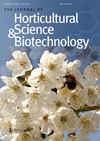从叶源愈伤组织中获得印度洋葵的离体器官发生及ISSR标记对遗传保真度的评估
IF 2.1
4区 农林科学
Q2 HORTICULTURE
Journal of Horticultural Science & Biotechnology
Pub Date : 2019-01-02
DOI:10.1080/14620316.2018.1447314
引用次数: 10
摘要
本研究报道了愈伤组织介导的籼稻离体再生。在添加4.52µM 2,4-二氯苯氧基乙酸(2,4- d)和8.88µM 6苄ladenine (BA)的培养基上,愈伤组织的增殖率最高(70.3%),但12周后愈伤组织仍未发生形态分化。而在添加2.68µM α-萘乙酸(NAA)、8.88µM BA和543µM硫酸腺嘌呤的MS培养基上继代培养,该绿色愈伤组织的多芽产生率最高(62.2%),芽伸长率也最高。在添加7.38µM吲哚-3-丁酸(IBA)的半强MS培养基上,发育良好的芽在离体生根效果良好。70%的离体再生植株在园林中成功建立,并且在形态上与供体植株相似。利用8条ISSR引物对这些离体再生植株进行遗传同源性分析。这一标准化的体外器官发生方案为籼稻种质资源的保存提供了一个良好的平台,也满足了草药行业的需求。本文章由计算机程序翻译,如有差异,请以英文原文为准。
In vitro organogenesis of Abutilon indicum (L.) Sweet from leaf derived callus and assessment of genetic fidelity using ISSR markers
This study reports on in vitro regeneration of Abutilon indicum plantlets through callus mediated organogenesis. The leaf explants implanted on Murashige and Skoogs (MS) medium supplemented with 4.52 µM 2, 4-Dicholorophenoxy acetic acid (2,4-D) and 8.88 µM 6 Benzyladenine (BA) showed highest response (70.3%) for callus proliferation, but these callus did not showed any morphogenetic differentiation on the same medium even after 12 weeks. Whereas, subsequent sub-culture of this green proliferated callus on MS medium added with 2.68µM α-Napthalene acetic acid (NAA), 8.88µM BA and 543 µM Adenine sulphate showed the highest frequency (62.2%) of multiple shoot-buds production and also elongation of shoots. Well developed shoots were efficiently rooted in vitro on half strength MS medium supplemented with 7.38 µM Indole-3-butyric acid (IBA). Seventy per cent of in vitro regenerated plantlets were successfully established in garden and were morphologically alike to the donor plants. The genetic homogeneity of these in vitro regenerated plantlets was also affirmed by inter simple sequence repeat (ISSR) analysis using eight ISSR primers. This standardised in vitro organogenesis protocol supplements a good platform for the conservation of A. indicum germplasms and also caters for the needs of the herbal industry.
求助全文
通过发布文献求助,成功后即可免费获取论文全文。
去求助
来源期刊
CiteScore
3.90
自引率
5.30%
发文量
67
审稿时长
3 months
期刊介绍:
The Journal of Horticultural Science and Biotechnology is an international, peer-reviewed journal, which publishes original research contributions into the production, improvement and utilisation of horticultural crops. It aims to provide scientific knowledge of interest to those engaged in scientific research and the practice of horticulture. The scope of the journal includes studies on fruit and other perennial crops, vegetables and ornamentals grown in temperate or tropical regions and their use in commercial, amenity or urban horticulture. Papers, including reviews, that give new insights into plant and crop growth, yield, quality and response to the environment, are welcome, including those arising from technological innovation and developments in crop genome sequencing and other biotechnological advances.

 求助内容:
求助内容: 应助结果提醒方式:
应助结果提醒方式:


